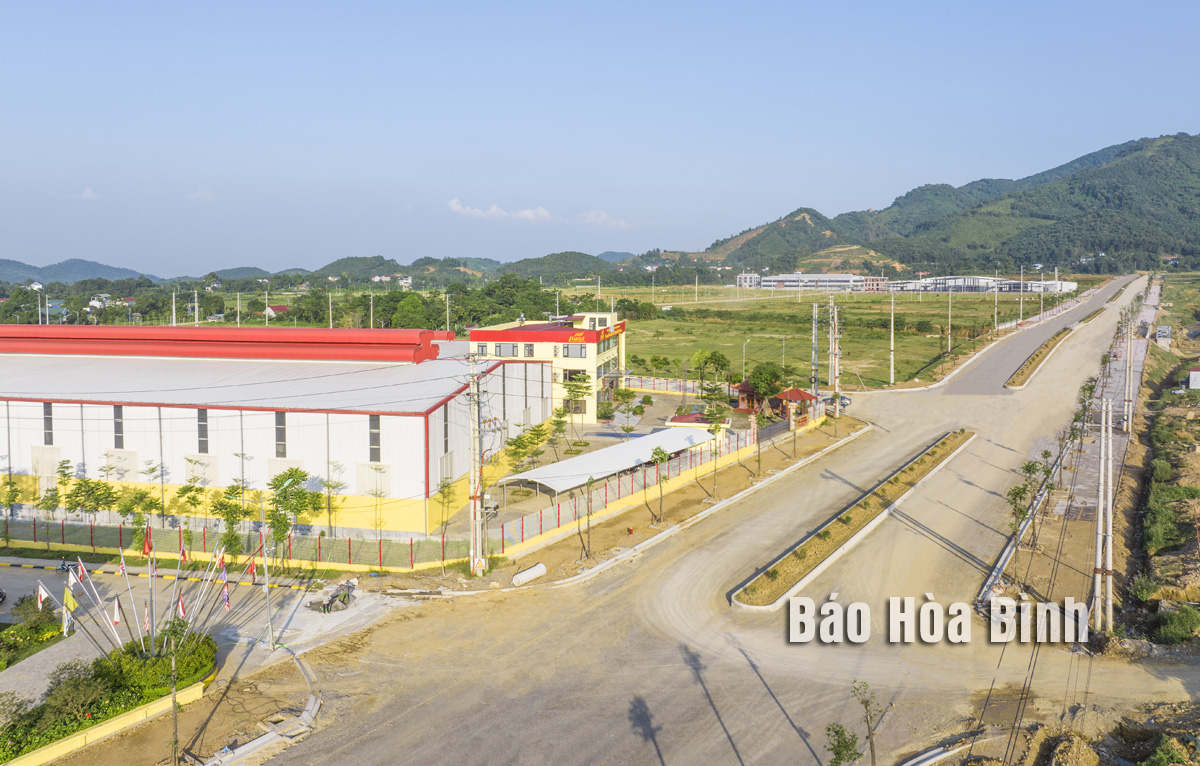
A revolution is unfolding in Hoa Binh province, with broad roads stretching across the terrain, industrial zones humming with machinery, organic vegetable fields rolling out in vibrant green expanses, and tourism destinations emerging, rich with cultural identity.
The determination and unity of the Party committees and
administrations at all levels and the local people have created foundational
changes in the province’s economic restructuring and renewal of the economic
growth model.
Hoa Binh
province has paid due attention to developing industrial parks and clusters. In
the Photo: The Tien Tien Industrial Cluster in Quang Tien commune, Hoa Binh
city.
The journey began in 2016 when Hoa Binh worked
to restructure its economic model. Four years later, the results were
promising, with economic scale rising by 41%, to reach nearly 52 trillion VND
(over 2 billion USD) in 2020, and per capita regional domestic product (GRDP)
touching 60.3 million VND.
Resolution
No.09-NQ/TU sets bold roadmap for economic development
The Standing Board of the provincial Party’s
Committee issued Resolution No.09-NQ/TU on December 31, 2021, a comprehensive
blueprint for local economic restructuring. The ambitious plan aims to bring
Hoa Binh's economic performance up to the national average by 2025, with specific,
transformative targets.
Key objectives include achieving an average
annual GRDP growth of 9%, increasing labor productivity by 8% annually, and
reducing poverty rates by 2.5-3% each year for 2021-2025.
The province set its sights on attracting 280
domestic projects worth over 120 trillion VND and 30 foreign direct investment
(FDI) projects valued at some 1 billion VND.
Under the resolution, various large-scale
projects and plans have been brought into full play, with the one on
restructuring the local economy in tandem with the renewal of economic growth
motive aimed at improving the efficacy of investment allocation and use,
developing industries and projects on the basis on the local strengths and
those with high added value and competitive edge, and enhancing labour
productivity, among others.
Capitalising on the Government’s support, the
province has issued various special policies to attract investments and
mobilise resources. Besides, the national target programmes on building
new-style rural areas and sustainable poverty alleviation have been integrated
with the economic restructuring efforts.
The provincial planning for 2021-2030 with a
vision to 2050 was greenlighted by the Prime Minister in late 2023. It looks to
inclusive and harmonious development with four pillars of processing and
manufacturing industry, clean and organic agriculture, tourism, and development
of satellite urban areas in tandem with the preservation of local ethnic
groups’ culture. This is the guiding principle for the province to restructure
its economic sectors in an effective and sustainable fashion.
A quiet yet powerful transformation unfolds as
those used to hillside farms and kitchen duties now set aside their routines to
learn to change. The entire rural landscape seems to awaken from years of
clinging solely to farmlands. Now locals are gearing towards the future with
new hopes. However, even with determination and strong consensus, the
province’s economic restructuring journey is not without challenges. What are
they and what has Hoa Binh done to overcome the obstacles?
To be continued
Luong Son district has identified 2025 as the year for the accelerated breakthrough to successfully implement the socio-economic development plan for the 5-year period from 2021 to 2025. The district has been focusing on executing the plans and trying to achieve a GRDP growth rate of approximately 15%.
Since the beginning of this year, under the direction of the Department of Agriculture and Environment, the Sub-Department of Agricultural, Forestry, and Fishery Product Quality Management has strengthened the integration of the professional activities to promote and guide the organizations and individuals in the production and trading of agricultural, forestry, and fishery products to comply with the legal regulations regarding the use of chemicals, pesticides and veterinary medicines in crop cultivation, livestock farming and aquaculture. They also provide guidance to processing and manufacturing establishments on keeping the records to trace the product origins and using food additives from the approved list according to the regulations.
Hoa Binh province saw a significant rise in state budget revenue in the first two months of 2025, heard a meeting chaired by Vice Chairman of the provincial People’s Committee Quach Tat Liem.
Ha Thi Ha Chi, a 26-year-old graduate in law, has taken an unconventional path by returning to her hometown in Mai Chau district to establish the Tong Dau Cooperative, creating stable jobs for local women and bringing Thai ethnic brocade weaving to the global market.
As the Lunar New Year 2025 approached, pork prices surged, creating a profitable season for farmers in Tan Vinh commune, Luong Son district. Taking advantage of the rising demand, Can Minh Son, a farmer from Coi hamlet, sold over 30 pigs at 69,000 VND/kg, each weighing more than 100 kg. After deducting expenses, his family earned a profit of over 50 million VND.
alternate member of the Central Party Committee, Secretary of the Hoa Binh provincial Party Committee Nguyen Phi Long on March 5 had a working session with Yan Jiehe, Founder and Chairman of the China Pacific Construction Group, one of China's largest private corporations in the field of transport infrastructure. Deputy Secretary of the provincial Party Committee, Chairman of the provincial People's Committee Bui Duc Hinh and leaders of provincial departments and sectors also attended the working session.



